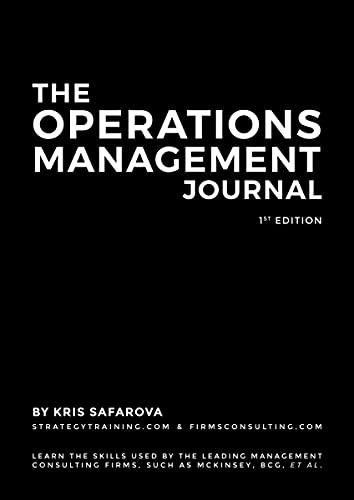Answered step by step
Verified Expert Solution
Question
1 Approved Answer
Question content area right Part 1 An Alabama lumberyard has four jobs on order , as shown in the following table. Today is day 2
Question content area right
Part
An Alabama lumberyard has four jobs onorder as shown in the following table. Today is day
on theyards schedule. In what sequence would the jobs be ranked according to the decision rules on theleft:
Job Due Date Durationdays
A
B
C
D
All dates are specified as manufacturing planning calendar days. Assume that all jobs arrive on day
Compute all times based on initiating work on day
a Using the FCFSfirst come, firstserved decision rule for sequencing thejobs the order isassume that jobs came in the order in which they are listed in thetable:
Part
The average tardinessjob lateness for the sequence developed using the FCFS rule days round your response to two decimalplaces
Part
The average completion timeflow time for the sequence developed using the FCFS rule days round your response to two decimalplaces
Part
The percentage utilization for the sequence developed using the FCFS ruleenter your response as a percentage rounded to two decimalplaces
b Using the SPTshortest processingtime decision rule for sequencing thejobs the order isto resolve atie use the order in which the jobs werereceived:
Part
The average tardinessjob lateness for the sequence developed using the SPT rule days round your response to two decimalplaces
Part
The average completion timeflow time for the sequence developed using the SPT rule days round your response to two decimalplaces
Part
The percentage utilization for the sequence developed using the SPT ruleenter your response as a percentage rounded to two decimalplaces
c Using the LPTlongest processingtime decision rule for sequencing thejobs the order isto resolve atie use the order in which the jobs werereceived:
Part
The average tardinessjob lateness for the sequence developed using the LPT ruledays round your response to two decimalplaces
Part
The average completion timeflow time for the sequence developed using the LPT ruledays round your response to two decimalplaces
Part
The percentage utilization for the sequence developed using the LPT ruleenter your response as a percentage rounded to two decimalplaces
d Using the EDDearliest duedate decision rule for sequencing thejobs the order isto resolve atie use the order in which the jobs werereceived:
Part
The average tardinessjob lateness for the sequence developed using the EDD ruledays round your response to two decimalplaces
Part
The average completion timeflow time for the sequence developed using the EDD rule days round your response to two decimalplaces
Part
The percentage utilization for the sequence developed using the EDD ruleenter your response as a percentage rounded to two decimalplaces
e Using the Critical RatioCR scheduling rule for sequencing thejobs the orderis:
Part
The average tardinessjob lateness for the sequence developed using the CR ruledays round your response to two decimalplaces
Part
The average completion timeflow time for the sequence developed using the CR ruledays round your response to two decimalplaces
Part
The percentage utilization for the sequence developed using the CR ruleenter your response as a percentage rounded to two decimalplaces
Step by Step Solution
There are 3 Steps involved in it
Step: 1

Get Instant Access to Expert-Tailored Solutions
See step-by-step solutions with expert insights and AI powered tools for academic success
Step: 2

Step: 3

Ace Your Homework with AI
Get the answers you need in no time with our AI-driven, step-by-step assistance
Get Started


